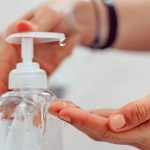 An agent that inhibits the growth and development of microorganisms.
An agent that inhibits the growth and development of microorganisms.
Preventing decay or putrefaction, a substance inhibiting the growth and development of microorganisms.
Destroys or inhibits microorganisms that cause infection.
Substance that prevents putrefaction; the decay of cells, and infection.
A substance that inhibits the growth and development of microorganisms without necessarily killing them.
A substance that prevents or inhibits the growth of microorganisms on animate surfaces, such as skin.
Any substance that inhibits the growth and reproduction of microorganisms.
A substance used to prevent infection by hindering the growth of infectious agents.
Something that prevents or arrests the growth or action of microorganisms (such as on living tissue).
An herb that inhibits the growth of bacteria on living tissue.
Preventing sepsis, decay, putrefaction; an agent that kills microbes.
Prevents infection or putrefaction; a disinfecting agent.
A substance that controls infection and helps prevent tissue degeneration.
Agent that destroys and prevents the development of microbes.
A substance that inhibits the growth of microorganisms.
Inhibits the development of pathogens that cause infection.
Prevents the growth of organisms that cause disease.
A chemical agent that meets the criteria of a disinfectant and is suitable for topical application.
Prevention or arrest of bacterial growth and decay.
Preventing harmful microorganisms from spreading.
Destroying infection-causing microorganisms.
Agent (e.g., soap) that slows or stops the continuing growth of microoganisms but may not actually MU them.
Chemical substances (not including chemotherapeutic agents) which prevent the growth and development of micro-organisms, with or without their death. Such substances may to some extent be injurious to body cells. Antiseptics used clinically include mercury salts, halogens, organic metallic compounds, alcohols, aldehydes, phenols, oxidizing agents, soaps and dyes. Only rarely are clinical antiseptics active against spore-bearing bacteria, but glutaraldehyde has been found to possess activity of this nature.
Substances that destroy or inhibit the growth of bacteria and other microorganisms. Antiseptics are used topically to treat wounds and infections, to sterilize surfaces and medical instruments, to promote general hygiene, to preserve foods, and to purify sewage. Common antiseptic chemicals include iodine, alcohol, hydrogen peroxide, and boric acid, each of which works differently. Iodine, for instance, can kill bacteria within 30 seconds, while other antiseptics work more slowly.
A chemical that destroys or inhibits the growth of disease-causing bacteria and other microorganisms and is sufficiently nontoxic to be applied to the skin or mucous membranes to cleanse wounds and prevent infections or to be used internally to treat infections of the intestine and bladder. Examples are gentian violet, dequalinium, and hexamine.
Antiseptics prevent the growth of disease causing micro-organisms without damaging living tissues. Among chemicals used are boric acid, carbolic acid, hydrogen peroxide and products based on coal tar, such as cresol. Chlorhexidines, iodine, formaldehyde, flavines, alcohol and hexachlorophane are also used. Antiseptics are applied to prevent infection for example, in preparing the skin before operation. They are also used externally to treat infected wounds.
Substance which prevents the proliferation of pathogenic germs inside the body or on its surface.
A substance that kills or inhibits the growth of disease-causing bacteria and other microorganisms.
Chemical germicides formulated for use on skin; registered and regulated by the Food and Drug Administration.
A substance that prevents infection by inhibiting the growth of microorganisms.
Antiseptics are substances applied to the skin with the purpose of eradicating bacteria and other microorganisms, thus preventing infection and sepsis. It is important to differentiate antiseptics from asepsis, which pertains to the creation of a germ-free environment. Antiseptics, unlike disinfectants, which are too potent for bodily use and are employed to sanitize inanimate objects, are milder in nature.
Antiseptic fluids are commonly employed for cleansing wounds during bathing, while antiseptic creams are applied to wounds before they are dressed. Several well-known antiseptics include chlorhexidine, cetrimide, hexachlorophene, and iodine-containing compounds.
Something that hinders the growth of microorganisms, like bacteria, without necessarily causing their complete destruction.
A substance that inhibits the growth or activity of microorganisms.
